毛笔英文书法
- 格式:pdf
- 大小:6.28 MB
- 文档页数:3
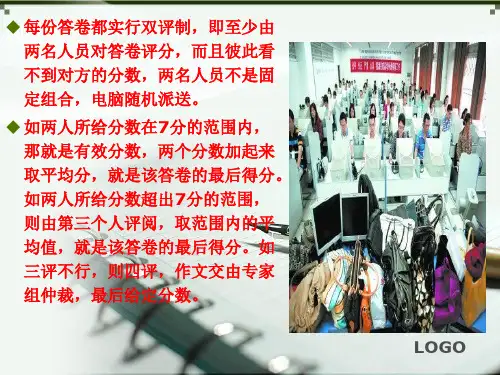

如何写出漂亮的英语字?你造吗?Calligraphy:中国书法、英语书法•Calligraphy: 书法•Chinese calligraphy: 中国书法•English calligraphy: 英语书法•Calligrapher: 书法家•Handwriting:写字、手写•Penmanship: 手写的艺术How does your handwriting look?如何用英语形容字好看、难看?写一手漂亮的字:You''ve got beautiful handwriting!字写得很丑:•Sloppy:字写得难看•Chicken scratch: 像鸡爪子抓出来的字写得草:Cursive: 字潦草、不容易看懂*Cursive还有一个意思是连笔,包括清晰、不潦草的连笔;*美国小学生也会练习写cursive.*Practising writing: 外国人从小会练字吗?Start in elementary school: 美国小学生会开始练字Start with cursive: 从连笔练起Handwriting does say something about the person: 字如其人But handwriting in English isn''t as important as it is in Chinese: 但是英语里写字的重要性不如中文If teachers can read it, they''ll let it pass: 老师看得懂,就可以,不会特别批评字难看How to improve your handwriting?怎么练漂亮的英语字?最好的方法,就是买这种三条线的本子:Three-lined notebooks: 三条线的本子It helps you structure your handwriting: 会帮你规范书写就像我们小时候练字的田字格大写、小写怎么说?•Upper case/capital letters: 大写•Lower case: 小写Different fonts: 各种字体Copperplate: 铜板体最古典Copperplate font: 铜板体Classic and classical: 既经典又古典Lots of loops: 很多圈圈Starting point for calligraphy: 练英语书法的人会从铜板体入门Gothic font: 哥特体最庄重Gothic: 哥特Gothic style: 哥特风格Reminds me of vampires: 让人联想到吸血鬼It''s quite dark: 有点儿黑暗Many old newspapers have their name in Gothic font: 很多历史悠久的报纸,名字都是哥特体Italics make everything beautiful!斜体,最简单美化手写的方法Italics: 斜体发音是?''t?l?ks,“I''发ai的音Slanted: 斜的Standard: 标准、端正Comic Sans: 最幼稚的字体Comic sans: 漫画字体People always make fun of this font: 这是最被嘲笑的字体It''s like a child''s handwriting: 看起来很幼稚*职场上,比如做英语PPT,最好别用这个字体*Different types of pens: 各种笔,英语怎么说?Fountain pen: 钢笔Ball pen: 圆珠笔Brush: 毛笔Nib: 笔头Calligraphy in action: 英语书法哪里用?Most used on invitations, especially wedding invitations:最常用在请帖上,特别是结婚喜帖Hire a calligrapher to handwrite the invitations: 新人会雇一位会书法的人帮他们手写You can do it by yourself:也可以自己尝试Write it in Italics and cursive: 写斜体、连写,看起来会很漂亮*可以买之前提到的三行线本子练一下*从高中到现在断断续续练了七八年中文字,仍旧只能保证练字簿上的字好看,想着练中文字这条路实在走不通,便开始曲线救国,另寻他法---练英文字!我从开始练到可以快速写出一手漂亮的英文字一共历时3个月,每日练字时间4小时,所以想要练字的小伙伴们,你们的福音到啦!话不多说,直接上干货。
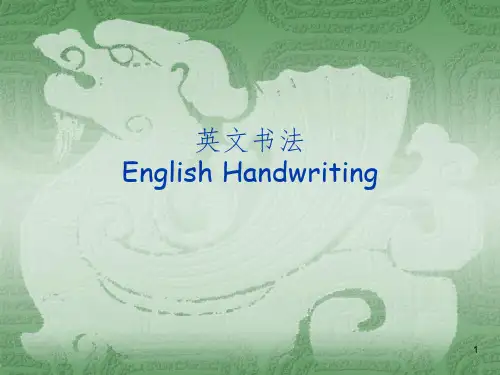
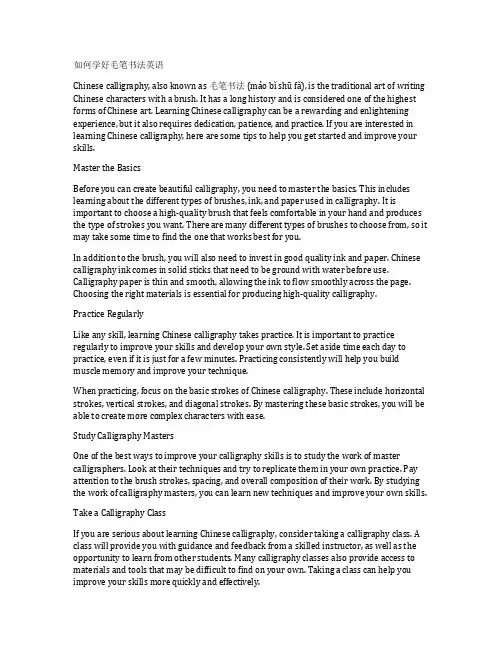
如何学好毛笔书法英语Chinese calligraphy, also known as 毛笔书法(máo bǐ shū fǎ), is the traditional art of writing Chinese characters with a brush. It has a long history and is considered one of the highest forms of Chinese art. Learning Chinese calligraphy can be a rewarding and enlightening experience, but it also requires dedication, patience, and practice. If you are interested in learning Chinese calligraphy, here are some tips to help you get started and improve your skills.Master the BasicsBefore you can create beautiful calligraphy, you need to master the basics. This includes learning about the different types of brushes, ink, and paper used in calligraphy. It is important to choose a high-quality brush that feels comfortable in your hand and produces the type of strokes you want. There are many different types of brushes to choose from, so it may take some time to find the one that works best for you.In addition to the brush, you will also need to invest in good quality ink and paper. Chinese calligraphy ink comes in solid sticks that need to be ground with water before use. Calligraphy paper is thin and smooth, allowing the ink to flow smoothly across the page. Choosing the right materials is essential for producing high-quality calligraphy.Practice RegularlyLike any skill, learning Chinese calligraphy takes practice. It is important to practice regularly to improve your skills and develop your own style. Set aside time each day to practice, even if it is just for a few minutes. Practicing consistently will help you build muscle memory and improve your technique.When practicing, focus on the basic strokes of Chinese calligraphy. These include horizontal strokes, vertical strokes, and diagonal strokes. By mastering these basic strokes, you will be able to create more complex characters with ease.Study Calligraphy MastersOne of the best ways to improve your calligraphy skills is to study the work of master calligraphers. Look at their techniques and try to replicate them in your own practice. Pay attention to the brush strokes, spacing, and overall composition of their work. By studying the work of calligraphy masters, you can learn new techniques and improve your own skills.Take a Calligraphy ClassIf you are serious about learning Chinese calligraphy, consider taking a calligraphy class. A class will provide you with guidance and feedback from a skilled instructor, as well as the opportunity to learn from other students. Many calligraphy classes also provide access to materials and tools that may be difficult to find on your own. Taking a class can help you improve your skills more quickly and effectively.Experiment with Different StylesChinese calligraphy has many different styles, each with its own unique characteristics. Experimenting with different styles can help you find your own voice as a calligrapher. Try practicing in different styles, such as regular script (楷书 - kǎi shū), cursive script (草书 -cǎo shū), and seal script (篆书 - zhuàn shū). By exploring different styles, you can discover what works best for you and develop your own unique style.Be Patient and PersevereLearning Chinese calligraphy is a long process that requires patience and perseverance. It is important to be patient with yourself and not get discouraged if you make mistakes. Remember that calligraphy is a form of art, and art is subjective. Embrace the process of learning and enjoy the journey of improving your skills. With time and practice, you will see improvement in your calligraphy.In conclusion, learning Chinese calligraphy is a rewarding and fulfilling experience. By mastering the basics, practicing regularly, studying calligraphy masters, taking a calligraphy class, experimenting with different styles, and being patient and persevering, you can improve your skills and develop your own unique style as a calligrapher. With dedication and practice, you can become proficient in the art of Chinese calligraphy.。
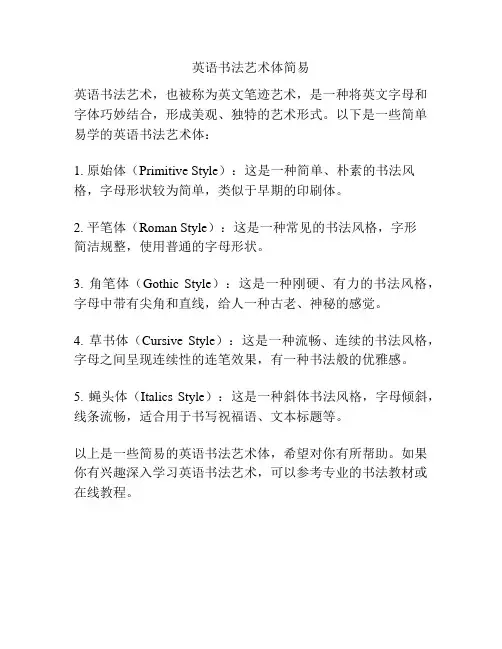
英语书法艺术体简易
英语书法艺术,也被称为英文笔迹艺术,是一种将英文字母和字体巧妙结合,形成美观、独特的艺术形式。
以下是一些简单易学的英语书法艺术体:
1. 原始体(Primitive Style):这是一种简单、朴素的书法风格,字母形状较为简单,类似于早期的印刷体。
2. 平笔体(Roman Style):这是一种常见的书法风格,字形
简洁规整,使用普通的字母形状。
3. 角笔体(Gothic Style):这是一种刚硬、有力的书法风格,字母中带有尖角和直线,给人一种古老、神秘的感觉。
4. 草书体(Cursive Style):这是一种流畅、连续的书法风格,字母之间呈现连续性的连笔效果,有一种书法般的优雅感。
5. 蝇头体(Italics Style):这是一种斜体书法风格,字母倾斜,线条流畅,适合用于书写祝福语、文本标题等。
以上是一些简易的英语书法艺术体,希望对你有所帮助。
如果你有兴趣深入学习英语书法艺术,可以参考专业的书法教材或在线教程。
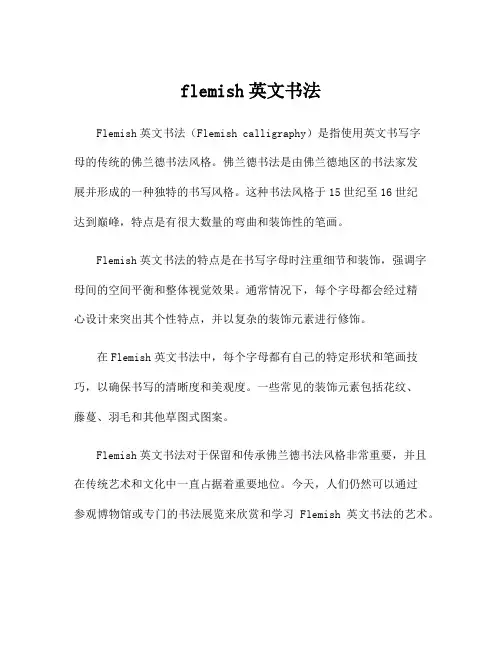
flemish英文书法
Flemish英文书法(Flemish calligraphy)是指使用英文书写字
母的传统的佛兰德书法风格。
佛兰德书法是由佛兰德地区的书法家发
展并形成的一种独特的书写风格。
这种书法风格于15世纪至16世纪
达到巅峰,特点是有很大数量的弯曲和装饰性的笔画。
Flemish英文书法的特点是在书写字母时注重细节和装饰,强调字母间的空间平衡和整体视觉效果。
通常情况下,每个字母都会经过精
心设计来突出其个性特点,并以复杂的装饰元素进行修饰。
在Flemish英文书法中,每个字母都有自己的特定形状和笔画技巧,以确保书写的清晰度和美观度。
一些常见的装饰元素包括花纹、
藤蔓、羽毛和其他草图式图案。
Flemish英文书法对于保留和传承佛兰德书法风格非常重要,并且在传统艺术和文化中一直占据着重要地位。
今天,人们仍然可以通过
参观博物馆或专门的书法展览来欣赏和学习Flemish英文书法的艺术。
毛笔英文书法入门基础教学英语圆体中,相对于横画,竖画出现的频率要高一些,难度也稍微大一点,大致分为2种。
今天介绍第一种常见的竖,我们可以称它为右弧竖。
基本写法:1,它由1/2处开始,斜向上轻轻画出细线2,到上面的主体线时画出弧线直到顶端,(弧线不可太宽也不可太窄)再向左转3,完成曲线后再接着结束处,由轻渐重,转锋向下,然后中锋运行。
直线要穿过先前转折的地方4,运行至基准线时稍顿后提笔这种竖的代表单词有h和k【h】的写法:1,笔尖从1/2处起笔,轻轻向上提2,到达上面的主体线时画出弧线直到顶线,(弧线不可太宽也不可太窄)再向左转3,完成曲线后再接着结束处,由轻渐重,转锋向下,然后中锋运行。
直线要穿过先前转折的地方4,运行至基准线时稍顿后提笔5,从基准线轻轻向上提,至主体线时由轻渐重,转锋向下,至适当处,圆转向右,边行边提笔出锋【k】有2种写法,第一种k的写法1,笔尖从1/2处起笔,轻轻向上提2,到达上面的主体线时画出弧线直到顶线,(弧线不可太宽也不可太窄)再向左转3,完成曲线后再接着结束处,由轻渐重,转锋向下,然后中锋运行。
直线要穿过先前转折的地方4,运行至基准线时稍顿后提笔5,从主体线斜向下,由轻渐重,再由重渐轻,画出一个圆弧至1/2处提笔6,从1/2处,由轻渐重,再由重渐轻,画出一个圆弧提笔出锋第二种k的写法:1,笔尖从1/2处起笔,轻轻向上提2,到达上面的主体线时画出弧线直到顶线,(弧线不可太宽也不可太窄)再向左转3,完成曲线后再接着结束处,由轻渐重,转锋向下,然后中锋运行。
直线要穿过先前转折的地方4,运行至基准线时稍顿后提笔5,从1/2处,由轻渐重,再由重渐轻,画出一个圆弧回到1/2处提笔6,从1/2处,由轻渐重,再由重渐轻,画出一个圆弧提笔出锋。
英文书法书写技巧第一节概述英文字母共26个,它的书写比汉字简单得多,也容易得多,但是,任何一门艺术都有自己的规律和要求。
学习任何一门艺术都是分层次、按阶段,日臻完善,渐入佳境的。
学习英文书写也是如此。
初学者必须熟悉字体的形式、组合和比例,熟悉基本笔画、笔顺和运笔方法。
在此基础上,再熟悉大小写字母的配合及连写。
只有这样扎扎实实地练好书写基本功,才能写出优美、流畅的英文字。
一、字母规格英文字母的规格分上中下三部分,可用四条平行线来分割,这就是我们平时用的三格练习薄。
最上面的一条线称为顶线,是字母书写的上边沿。
第二条线称为主体线,是小写字母主体的上边沿。
第三条线称为基准线,是大多数大写字母和无下伸部分的小写字母的下边沿。
第四条线称为底线,是字母下伸部分的下边沿。
我们把第一条线和第二条线之间的区域称为上伸区,将第三条线和第四条线之间的区域称为下伸区,最中间的区域称为主体区(如图2-1所示)顶线上伸区主体线主体区基准线下伸区底线图2-1二、字母结构任何字母形式都可以简化成基本骨架,体现出每个字母的基本结构。
从几何图形来说,英文字母可分为方、圆、三角三种(如H、O、A),其整体的外形多为长方形,个别字母为正方形(如M、W);从结构来说,可以分为单结构(如O、D)和双结构(如B)两类。
字母表中的大写字母严格以书写线为准,高度相同。
小写字母,除了字母的基本高度,还有笔画的上伸和下伸部分。
小写字母有较多的结构特征和形式。
字母内部的空间有十分重要的协调比例的作用。
这是从美学角度来考虑字母整体形状的。
例如大写字母A,A中间的横道固定在一点上,使内三角和字母底部的空间保持平稳,给人以劲健舒展的感觉,让人看着美观。
三、字母形体比例字母的比例就是高度和宽度的固定关系。
字母的形体都有一定的比例。
不同的字母有着不同的宽度。
一般来说,字母的比例本身应给人以美感。
字母表中所有字母都应统一于一个合理的比例系统。
手写体中的小写字母,除i、l、m、w和z字母外,其余字母的宽度基本相同。
【国际体】毛笔英文书法中长竖的写法二三把刷子徐彪主笔中长竖写法有两种,第二种写法是:从顶线起笔,斜向下逐渐用力,大约行至一半时,边行笔边提笔。
与第一种不同的是,两端细中间粗。
【M】的写法:1,从顶线起笔,轻轻向左下方行笔,角度不宜过大,快至基准线时抬起,最后以点或盘旋结束;2,再从顶线起笔,斜向下逐渐用力,大约行至基准线时,边行笔边提笔,向右细线回到顶线;3,再一次从顶线起笔,斜向下逐渐用力,大约行至基准线时,边行笔边提笔,向右细线回到上方1/2处。
【N】的写法:1,从顶线起笔,轻轻向左下方行笔,角度不宜过大,快至基准线时抬起,最后以点或盘旋结束;2,再从顶线起笔,斜向下逐渐用力,大约行至一半时,边行笔边提笔;3,从基准线开始,轻轻向右上方行笔,同样角度不宜过大,快至顶线时弯曲,最后以点或盘旋结束,与第一笔对称。
【V】的写法:1,从主体线上3/4处起笔,向左旋转一圈后,逐渐加重力道,再旋转向右至顶线;2,从顶线起笔,斜向下逐渐用力,大约行至一半时,边行笔边提笔;3,从基准线开始,轻轻向右上方行笔,快至顶线时弯曲,最后以点或盘旋结束。
【W】的写法:1,从主体线上3/4处起笔,向左旋转一圈后,逐渐加重力道,再旋转向右至顶线;2,从顶线起笔,斜向下逐渐用力,大约行至一半时,边行笔边提笔;3,从基准线开始,轻轻向右上方行笔至顶线;4,再从顶线起笔,斜向下逐渐用力,大约行至一半时,边行笔边提笔,与第二笔一致且平行;5,再从基准线开始,轻轻向右上方行笔,快至顶线时弯曲,最后以点或盘旋结束。
【Z】的写法:1,从主体线上3/4处起笔,向左旋转一圈后,逐渐加重力道,再旋转向右至顶线;2,从顶线起笔,斜向下逐渐用力,大约行至一半时,边行笔边提笔;3,从基准线处起笔,由轻渐重画出弧线直至主体线,转锋向下,然后中锋运行,运行回快到达基准线时,圆转向右,边行边提笔出锋4,从主体线上1/2处起笔,波浪形向右行笔至右边再提笔出锋。
英语书法26个字母作品The art of calligraphy has been a cherished skill for centuries. In English, the beauty of handwriting is often overlooked, but it can be a delightful way to express oneself. Each letter, from A to Z, can be crafted with precision and elegance.The alphabet begins with 'A', a symbol of aspiration and ambition. Its triangular shape stands tall, much like the aspirations of those who strive for greatness.Moving to 'B', it's a letter that bends and curves, representing the flexibility and resilience needed in life.It's a reminder that we must adapt to change.'C' is a smooth, flowing letter, much like the continuous journey of learning. It's a gentle reminder that knowledge is a path without an end.'D', with its strong base, signifies the importance of foundations. It's a symbol of stability and the need for a solid start in any endeavor.'E', the most commonly used letter, is simple yet versatile. It teaches us the value of simplicity and thepower of being present in every word.'F', with its sharp end, reminds us of the fine linesthat separate success from failure. It's a lesson in precision and focus.'G', with its loop and tail, is a letter that signifies generosity and grace. It's a reminder to give freely and to move with ease.'H' stands tall and straight, a symbol of honesty and integrity. It's a reminder to stand firm in our beliefs and values.'I', the smallest letter, represents individuality. It's a symbol of the unique spark that resides in each of us.'J', with its downward stroke, reminds us of the importance of humility. It's a lesson in staying grounded despite our achievements.'K', a letter with a sharp corner, signifies the need for decisiveness. It's a reminder to make choices with clarity and conviction.'L', with its long tail, represents the length of our journey. It's a symbol of the road ahead and the need for patience.'M', a mountainous letter, signifies the challenges we face. It's a reminder that we must rise above our obstacles.'N', with its double hump, reminds us of the ups and downs of life. It's a symbol of resilience and the ability tobounce back.'O', a perfect circle, represents unity and wholeness. It's a reminder that we are all connected.'P', with its sharp peak, signifies the importance of pride. It's a lesson in taking pride in our work and achievements.'Q', a quirky letter, reminds us of the importance of uniqueness. It's a symbol of embracing our individuality.'R', with its curvy tail, signifies the twists and turns of life. It's a reminder that life is full of surprises.'S', a serpentine letter, represents the winding path of growth. It's a symbol of the continuous journey of self-improvement.'T', a sturdy letter, signifies the importance of truth. It's a reminder to stand firm in what is right.'U', with its open shape, represents the power of unity. It's a symbol of the strength that comes from working together.'V', a letter that points upwards, signifies victory.It's a reminder to keep striving for success.'W', a wave-like letter, reminds us of the waves of change. It's a symbol of the need to embrace change.'X', a letter of mystery, represents the unknown. It's a reminder to be curious and to seek knowledge.'Y', a forked letter, signifies the choices we make. It's a reminder that our decisions shape our future.'Z', the final letter, represents the end of a cycle.It's a symbol of completion and the beginning of a new journey.。